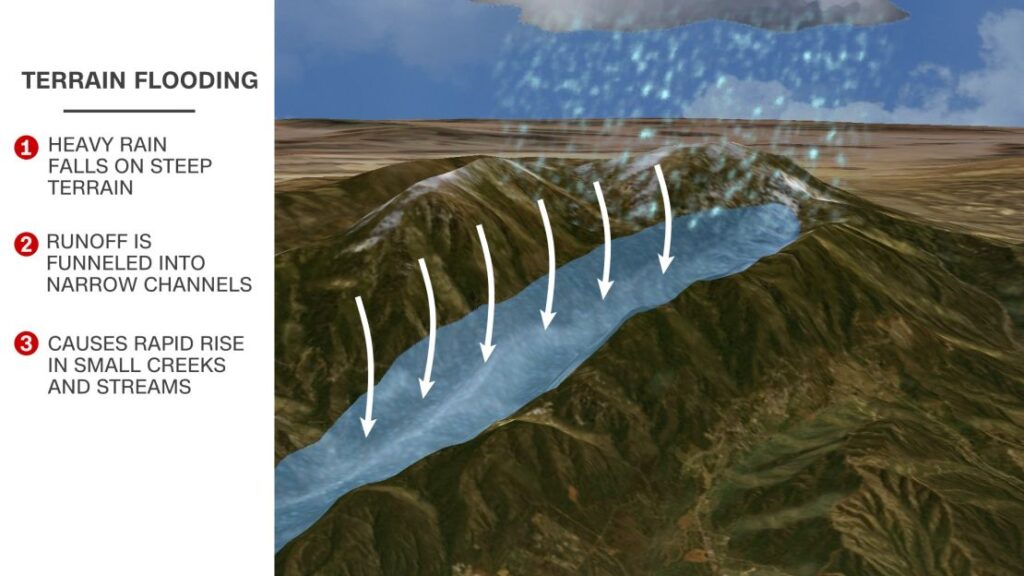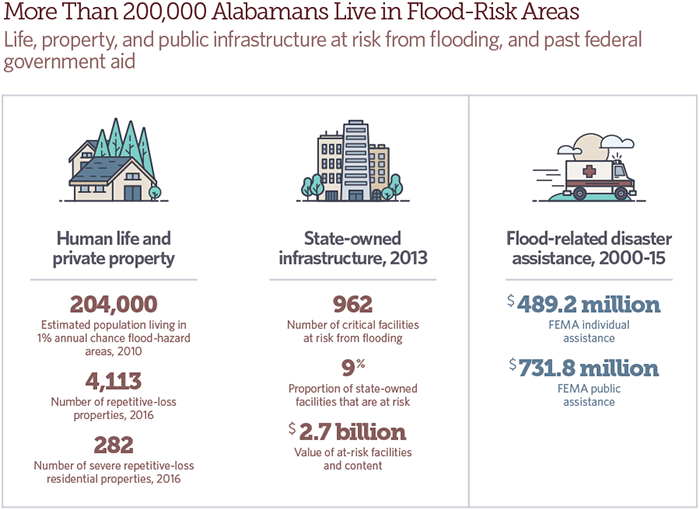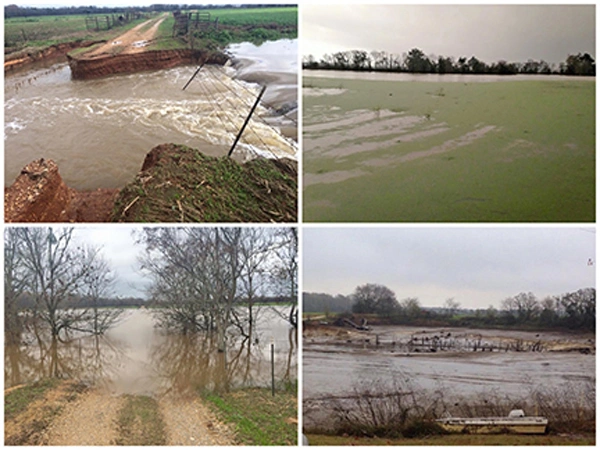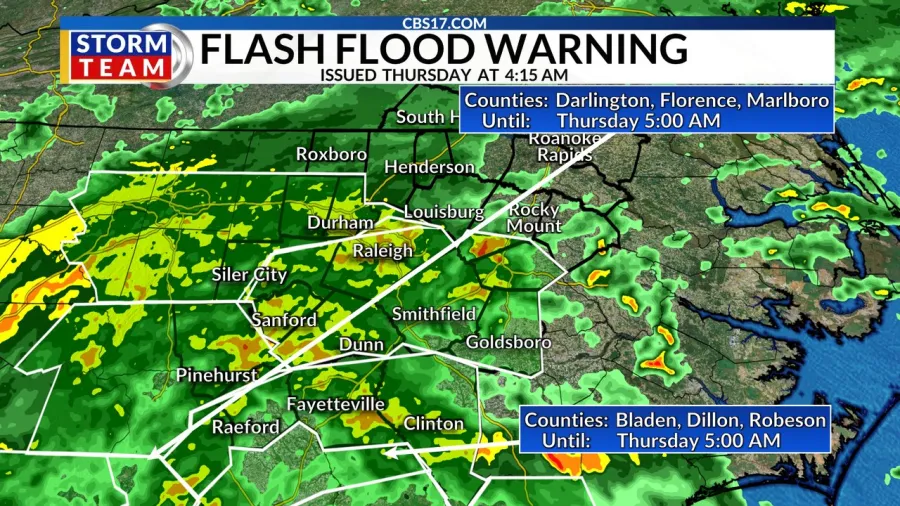Flash floods in Central Alabama are increasingly frequent and have severe consequences beyond the environmental impact. The Flash Flood Warning issued by the National Weather Service signals more than immediate danger it highlights a significant economic threat. This article explores the financial toll flash floods take on infrastructure, agriculture, businesses, and the broader economy, offering insights into how the region can better prepare for future incidents.
Causes of Flash Flooding
Central Alabama’s geographic location and climate contribute to frequent flash floods. The region’s flat terrain, combined with intense rainstorms, often leads to water accumulating faster than drainage systems can handle. Additionally, climate change exacerbates the unpredictability of weather patterns, causing more severe rainfall events. These factors make flash floods a recurring problem, resulting in devastating economic impacts across the state.

Immediate Economic Impacts
When a flood warning is issued, the immediate concerns are public safety and infrastructure. However, the financial toll begins to accumulate as soon as flooding occurs. Roads, bridges, and utilities are often damaged, requiring significant financial resources for repair. Small businesses, particularly those without flood insurance, suffer from physical damage and interrupted operations, leading to income loss. The overall economic burden in the first days following a flood can be overwhelming.

Impact on Agriculture
Agriculture is one of the hardest-hit sectors during flash floods in Central Alabama. The region’s farmers face crop destruction, soil erosion, and livestock losses, all of which have long-lasting economic effects. The cost of recovery, including soil restoration and replanting, can set back agricultural production for months, impacting both the local food supply and the wider economy. For many farmers, these flash floods translate into significant financial hardship, especially without proper insurance coverage.

Effect on Employment
The employment landscape in Central Alabama also takes a hit during flash floods. Many businesses, particularly those dependent on local infrastructure, may be forced to close, leading to temporary or permanent job losses. This reduction in employment decreases spending in the local economy, creating a ripple effect that impacts other sectors. The overall loss of productivity and economic stagnation can last long after the floodwaters recede, hampering recovery efforts.

Long-Term Economic Consequences
The economic impacts of flash flooding extend far beyond immediate damage. Over time, these recurring disasters can drive up insurance premiums, making coverage less affordable for businesses and homeowners. The rising costs of flood insurance can deter new business development and discourage investment in flood-prone areas. Additionally, repeated flooding can lead to population decline as people move to less flood-prone regions, further eroding the economic base of Central Alabama.
Response and Relief Measures
In the wake of a flash flood warning, the government and insurance companies play a crucial role in the recovery process. Federal aid programs like FEMA offer immediate relief, but long-term recovery often requires significant financial support from insurance claims. Unfortunately, many businesses struggle with underinsurance or denied claims, prolonging the economic downturn. Improved response strategies, including streamlined claims processing and government-backed relief initiatives, are essential to minimize long-term economic fallout.
Infrastructure Resilience Initiatives
Investing in infrastructure resilience initiatives is critical for protecting Central Alabama from the long-term economic effects of flash floods. Building flood-resistant roads, bridges, and drainage systems can significantly reduce the damage caused by future floods. Additionally, local governments are increasingly focusing on zoning regulations that prevent development in high-risk flood zones. These measures not only protect the economy but also reduce the financial strain on recovery efforts.
Business Recovery Strategies
For businesses, recovering from a flash flood involves both immediate and long-term strategies. Immediate steps include filing insurance claims, securing short-term financing, and communicating with customers about delays or closures. In the long term, businesses can invest in flood-proofing their properties, creating disaster recovery plans, and diversifying their income streams to mitigate the financial impact of future floods. These strategies can help businesses bounce back more quickly and contribute to the broader economic recovery of Central Alabama.
Environmental Sustainability Efforts
Flash floods are often a symptom of broader environmental issues. Climate change and poor land management practices contribute to the increased frequency and intensity of floods. To address these root causes, Central Alabama is investing in environmental sustainability efforts. Restoring wetlands, improving forest management, and reducing urban sprawl are key initiatives aimed at minimizing future flood risks. These efforts not only protect the environment but also help shield the local economy from the devastating effects of recurring floods.
Community Support and Impact
The social impact of flash floods is deeply intertwined with the economic consequences. Displaced families, damaged homes, and interrupted services lead to a reduced quality of life, which can be difficult to rebuild without community support. Nonprofits, local governments, and volunteer organizations play an essential role in helping communities recover. By providing temporary housing, financial assistance, and mental health services, these groups help restore both the social and economic fabric of Central Alabama.
Conclusion
In conclusion, the Flash Flood Warning system is vital for minimizing immediate damage, but long-term economic resilience in Central Alabama requires more than warnings. Infrastructure improvements, better insurance coverage, and sustainable environmental practices are essential to mitigate the economic toll of flash floods. With proactive efforts, Central Alabama can build a more flood-resilient economy, protecting both its people and businesses from the growing threat of flash floods.





